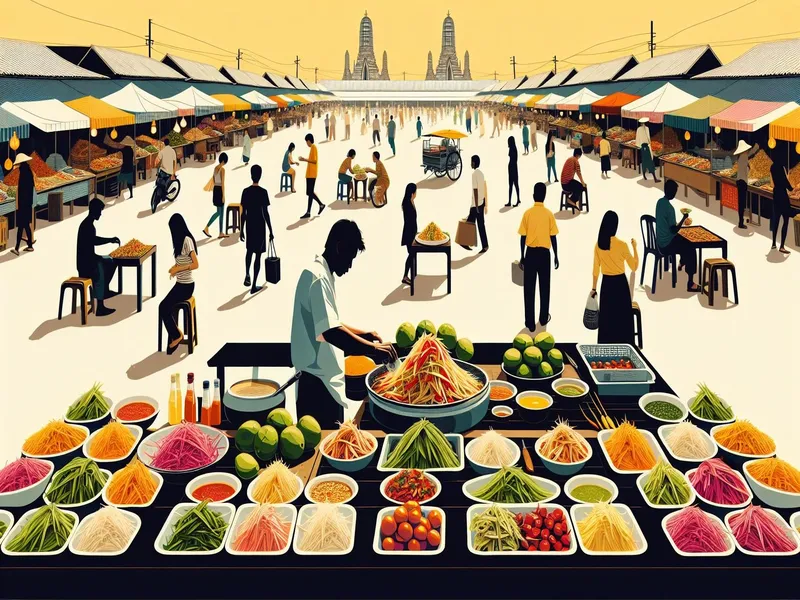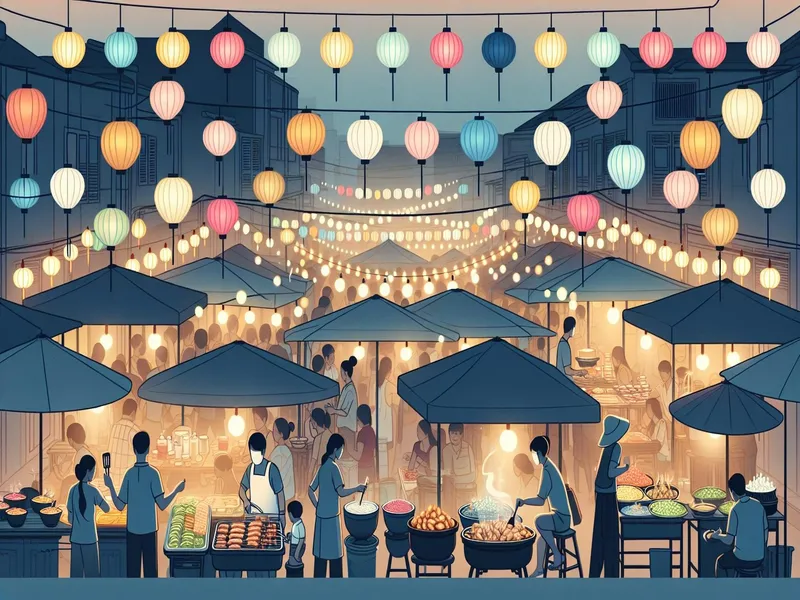
From the bustling street markets of Bangkok to the serene tea houses in Kyoto, there’s a world of flavors waiting to be discovered. Whether you’re craving spicy curries or delicate sushi, this guide will help you navigate Asia’s rich and diverse food scene.
Ignoring Asia’s culinary treasures means missing out on some of the most unique and delicious experiences travel can offer. You might find yourself stuck eating at tourist traps instead of savoring authentic local dishes that tell the story of their culture and history. Don’t let indecision rob you of these mouthwatering moments.
Having spent years traveling through Asia, I’ve tasted everything from Vietnam’s pho to Malaysia’s laksa. My firsthand experiences and insider tips will ensure you eat like a local wherever you go. Check out our travel activities guide for more ways to enrich your journey.
Whether you’re a seasoned traveler or planning your first trip, understanding where and what to eat can make all the difference. I’ll break down must-try dishes for various regions, ensuring your taste buds are as thrilled as your sense of adventure.
Discovering Asian Cuisine
Traveling through Asia is like embarking on a culinary treasure hunt. Every country, city, and even street corner offers something unique to tantalize your taste buds. Let me take you through some of my favorite discoveries in Asian cuisine.
Street Food Wonders
You can’t talk about Asian food without mentioning street food. It’s where you’ll find the heart and soul of local culinary traditions.
- Bangkok’s Night Markets: Picture this—you’re strolling through Bangkok’s Chatuchak Market, the aroma of grilled seafood wafting through the air. You stop by a stall selling Som Tum (spicy papaya salad). The vendor expertly mixes shredded papaya with lime juice, fish sauce, peanuts, and chili. One bite packs a punch that dances between spicy, sour, salty, and sweet.
- Taiwanese Night Markets: In Taiwan’s Shilin Night Market, I found Stinky Tofu—trust me, it’s an acquired taste but worth it for its crispy exterior and soft inside. This fermented tofu might smell pungent but once you get past that initial whiff, it’s quite delicious.
Regional Delicacies
Every region boasts dishes that tell stories of their culture and history.
- Japanese Sushi in Tokyo: Imagine sitting at a small sushi bar in Tokyo’s Tsukiji Fish Market. The chef places a piece of fresh Otoro (fatty tuna) on your plate. It’s so fresh that it almost melts in your mouth—a perfect balance of umami flavors.
- Dim Sum in Hong Kong: Dim sum is more than just food; it’s an experience. Sharing baskets filled with dumplings like Har Gow (shrimp dumplings) or Siu Mai (pork dumplings) while sipping on hot tea creates an atmosphere that’s both communal and intimate.
Hidden Gems
Sometimes the best meals are found off the beaten path.
- Vietnamese Pho Stalls: While wandering Hanoi’s narrow streets early one morning I stumbled upon an old lady serving pho from a tiny cart. Her broth was simmered for hours using beef bones star anise cinnamon cloves garlic ginger onions—creating layers of depth flavor.
- Malaysian Nasi Kandar Shops: In Penang Malaysia there’s this unassuming shop where they serve Nasi Kandar—a meal consisting rice mixed various curries meats vegetables pickles boiled eggs—the combinations endless each bite different yet harmonious blend spices textures tastes.
A Taste Of Fusion
Asian cuisine isn’t static; it evolves blends with other influences creating new exciting flavors.
- Korean-Mexican Fusion Tacos: In Seoul I tried Korean BBQ tacos stuffed kimchi bulgogi topped sriracha mayo cilantro—it was fusion heaven!
- Indian-Chinese Chilli Chicken: At Mumbai restaurant sampled Indo-Chinese dish Chilli Chicken which combines Chinese cooking techniques Indian spices resulting spicy tangy delight hard to resist seconds!
Regional Culinary Delights

Exploring Asia’s food scene is like opening a treasure chest; there’s always something new and delicious to discover. Let’s jump into the culinary wonders of Southeast Asia, East Asia, and South Asia.
Southeast Asia
Southeast Asian cuisine is all about bold flavors and fresh ingredients. I remember walking through Bangkok’s bustling streets, the aroma of Som Tum (spicy green papaya salad) hitting me from every corner. It’s crunchy, spicy, and tangy—an explosion of flavors in your mouth.
In Vietnam, you’ll find pho stalls on almost every street. Imagine slurping up hot broth with tender beef slices while sitting on tiny plastic stools—the experience itself adds to the flavor! And let’s not forget Malaysia’s Nasi Kandar shops in Penang; it’s like a buffet of curries that you mix and match over rice.
- Thailand: Som Tum
- Vietnam: Pho
- Malaysia: Nasi Kandar
East Asia
East Asian dishes often balance subtlety with sophistication. Tokyo’s sushi is world-famous for good reason. Picture this: melt-in-your-mouth tuna sashimi paired with perfectly seasoned rice—it’s simplicity at its finest.
Dim sum in Hong Kong offers a completely different vibe—a communal feast where steamed dumplings become the stars. Each bite reveals layers of delicate flavors wrapped in soft dough. It’s an intimate way to share food among friends or family.
Then there are Taiwan’s night markets where stinky tofu reigns supreme. Yes, it smells strong, but once you get past that initial whiff, the crispy exterior and soft interior are utterly worth it!
- Japan: Sushi
- Hong Kong: Dim Sum
- Taiwan: Stinky Tofu
South Asia
South Asian cuisine packs a punch with its spices and rich textures. In India, nothing beats savoring Chilli Chicken—a fusion dish that brings together Indian spices and Chinese cooking techniques.
I once found myself in Sri Lanka indulging in hoppers (bowl-shaped pancakes). These were served with coconut sambol—a spicy relish made from grated coconut—and various curries. The combination was both fiery and comforting.
Nepal offers momos (dumplings), often filled with spiced meat or vegetables. They’re perfect bites of joy especially when dipped into tomato chutney.
- India: Chilli Chicken
- Sri Lanka: Hoppers
- Nepal: Momos
Must-Try Asian Dishes

Exploring Asia’s culinary scene is like stepping into a world of endless flavors and surprises. From bustling street markets to tiny, tucked-away eateries, there’s always something new to taste.
Street Food
Street food is the heartbeat of many Asian cities. Imagine wandering through Bangkok at night, drawn by the aroma of grilled meats and spicy sauces. You can’t miss Som Tum—a fiery papaya salad that’s both refreshing and intense. In Taiwan, brace yourself for Stinky Tofu. Yes, it smells strong but tastes incredible with its crispy outside and soft interior. Hanoi’s streets are lined with pho stalls serving piping hot bowls of this aromatic beef noodle soup.
Must-try street foods:
- Thailand: Som Tum (spicy papaya salad)
- Taiwan: Stinky Tofu
- Vietnam: Pho (beef noodle soup)
Regional Specialties
Each region in Asia has its own culinary gems that reflect local culture and history. Japan’s sushi needs no introduction—fresh fish on perfectly seasoned rice is a simple yet artful dish you can’t skip when in Tokyo. Hong Kong’s dim sum offers bite-sized delights like shrimp dumplings and pork buns, best enjoyed with friends over tea. In Penang, Malaysia, try Nasi Kandar, a meal where rice is served with a variety of curries and side dishes—a true explosion of flavors.
- Japan: Sushi
- Hong Kong: Dim Sum
- Malaysia: Nasi Kandar
Drinks to Savor
When traveling through Asia, the drinks are as much an adventure as the food. Here are some traditional beverages and modern twists you should try.
Traditional Beverages
Asia’s traditional drinks offer a taste of its rich cultural heritage. In Thailand, try Cha Yen (Thai iced tea). This sweet, creamy tea is made from strongly brewed black tea, spiced with star anise and orange blossom water, then mixed with evaporated milk and sugar. I remember sipping this refreshing drink on a scorching day in Bangkok—it was pure bliss.
In Japan, sake is a must-try. This rice wine has been crafted for centuries and comes in various flavors depending on the brewing process. During my visit to Kyoto, I joined a sake tasting tour where I learned about the intricate process of fermenting rice into this delicate beverage while savoring different varieties.
India boasts masala chai—a spiced tea that combines black tea leaves with cardamom, cinnamon, ginger, cloves, and peppercorns. It’s usually served piping hot with milk and sugar. I’ve enjoyed many mornings in Delhi starting my day at local tea stalls where vendors expertly mix these spices to create a perfect cup.
Modern Twists
Modern twists on classic Asian beverages add excitement to any culinary journey. Bubble tea (boba) from Taiwan has taken the world by storm. This fun drink combines chewy tapioca pearls with milk or fruit-flavored teas—perfect for those who love textures in their drinks! The first time I tried bubble tea in Taipei felt like discovering a new world of flavors and sensations.
In South Korea, soju cocktails have become trendy among young locals and travelers alike. Soju is a clear distilled liquor traditionally made from rice but now often produced from other starches like sweet potatoes or barley. Mixed with fruit juices or sodas in colorful concoctions, these cocktails provide a delightful way to enjoy Korean nightlife.
Finally, don’t miss out on craft beers emerging across Asia’s urban centers like Tokyo’s thriving brewery scene where you can find unique brews infused with regional ingredients such as yuzu citrus or matcha green tea powder—offering an innovative take on beer that reflects Japan’s creative spirit.
Food Markets and Festivals
Food markets and festivals in Asia are like treasure chests bursting with flavors, colors, and aromas. You can uncover hidden gems at every turn. Let’s jump into some of the best spots to tantalize your taste buds.
Popular Food Markets
Asia’s food markets offer a sensory overload that you won’t forget. Chatuchak Market in Bangkok is an absolute must-visit. Here, you’ll find everything from spicy papaya salad (Som Tum) to grilled skewers of meat called Moo Ping. Another gem is Kuromon Ichiba Market in Osaka, Japan, where fresh sushi melts in your mouth like butter. For something truly unique, explore Donghuamen Night Market in Beijing; it’s famous for exotic snacks like scorpions on sticks! These markets aren’t just about eating—they’re cultural experiences.
Annual Food Festivals
Annual food festivals in Asia celebrate culinary traditions with flair. The Taipei Beef Noodle Festival is a feast for noodle lovers; vendors compete to make the best beef noodle soup you’ve ever tasted. If sweets are more your thing, head to Thailand’s Lopburi Monkey Buffet Festival, where monkeys (yes, real monkeys!) share fruit buffets with visitors—talk about monkeying around! In India, don’t miss the Goa Food and Cultural Festival, which showcases Goan cuisine steeped in Portuguese influence; think spicy vindaloo and sweet bebinca dessert. These festivals bring communities together through shared love of food.
Tips for Food and Drink Travelers
Traveling through Asia’s culinary world is an adventure for your taste buds. From street food stalls to high-end restaurants, there’s something for everyone.
How to Eat Like a Local
Eating like a local can make your trip unforgettable. Locals have insider knowledge about where to find the best dishes. Here are some tips:
- Ask Locals: When in doubt, ask someone who lives there. You might end up at a hole-in-the-wall spot with the best pho you’ve ever had.
- Embrace Street Food: Street vendors often serve the most authentic food. In Bangkok, I tried Som Tum from a cart, and it was life-changing.
- Visit Markets: Local markets are treasure troves of fresh ingredients and unique snacks. Chatuchak Market in Bangkok offers everything from grilled squid to mango sticky rice.
Remember, eating like a local means being adventurous and open-minded.
Staying Healthy Abroad
Staying healthy while indulging in new foods is essential. Here’s how you can enjoy your culinary journey without any hiccups:
- Drink Bottled Water: Tap water isn’t always safe. Stick to bottled water to avoid stomach issues.
- Eat Freshly Cooked Food: Freshly cooked meals are less likely to cause food poisoning. Look for busy stalls; high turnover means fresher food.
- Pack Medication: Carry basic meds like antacids or Imodium just in case you eat something that doesn’t agree with you.
When I visited Hanoi, I made sure every meal was freshly prepared right before my eyes at bustling street stalls—no regrets!
Wrapping Up
Exploring Asia’s culinary world is an adventure that goes beyond mere dining. It’s a journey through history culture and the very essence of each region. From bustling street markets to hidden local eateries every meal tells a story.
The vibrant flavors and diverse dishes I’ve encountered have deepened my appreciation for this incredible continent. Whether you’re savoring sushi in Tokyo or sipping masala chai in India there’s always something new to discover.
So go ahead embrace the unknown and let your taste buds lead the way. There’s no better way to experience Asia than through its food and drink. Happy travels!